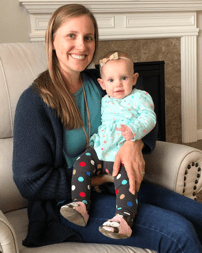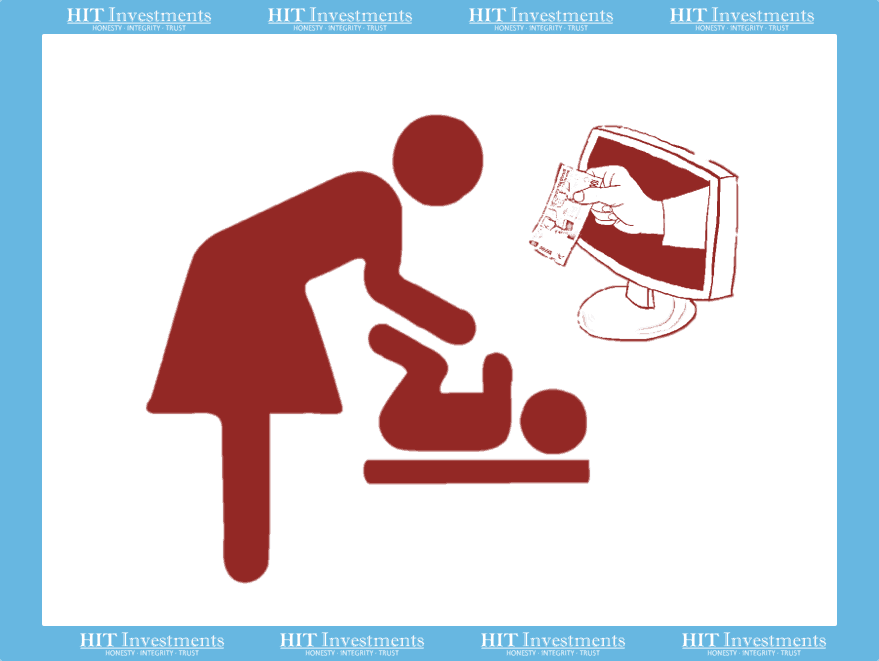As our domestic stock market has become expensive, we continue to look for something better. One area HIT revisited in 2018 was the category of fixed income. The high-level overview of an asset class worth more than $247 trillion has since led me to focus on the specific sub-category of peer to peer lending. To my surprise, my sister showed a keen interest in the topic and as I started to dig, I found her in the trenches alongside me. We have since teamed up and researched over 100 different Peer to Peer lending platforms across the world.
So without further ado, I’d like to introduce you to Kristin. This is her first post on HIT Investments and she takes us on her journey from changing diapers to becoming a peer to peer lender (while still changing diapers).
Kristin’s Journey – From Diapers to Lender

Recently I started working with my brother, Stephen Read, Founder and Manager of HIT Investments. It’s been a lot of learning and I’ve loved getting to exercise my brain again. I graduated from the University of Illinois and started my career teaching high school physics and geology.
I regularly kept up on math and science education, as well as the latest research on teaching. Then I had kids; my first was born in 2015 and then two more came in quick succession. Staying at home and raising children is physically demanding. While I see and feel the rewards of my labor on a daily basis, I craved something more to stimulate and exercise my brain again. So, when Stephen asked me to help him research Peer to Peer lending, I was all in, even though I had limited knowledge on the subject.
Peer to Peer Lending: What I’ve learned
1. What Is P2P Lending?
Here are my two sentences take: It’s a way people exchange money without having to go through a traditional bank. By removing the middlemen, more of the interest charged to the borrower makes it into the pockets of the lender.
The more I learn the more I want to become a lender.
2. Not All P2P Lending Platforms Are Created Equal
Peer to peer lending is fairly new in general and, as of a couple of months ago, was completely new to me. I had quite a few questions to answer before investing my money. The first question was “what types of peer to peer loan platforms are out there?”
I found that there was a wide variety. Just about any type of loan you can think of, there is a platform for it. Think jewelry, sailboats, houses, energy, cars, credit card debt, and home improvement projects to name a few.
This led to the second question, which was “how secure are the loans?” Each of these platforms carried different risks. Some platforms that operated a couple of years ago no longer exist today. Others seemed very stable. The most secure platforms tended to involve real estate. Most of the real estate platforms had loans secured against the physical property. The properties themselves were easy to investigate online.
3. Focusing In And Exercising My Brain On The Real Estate Options
It was exciting to learn about investing in real estate without having to actually purchase a property or go through the pains of being a landlord. It also seemed to be a fairly secure way to diversify my investments that are almost entirely invested in mutual funds.
There were also plenty of options, with some platforms having a minimum investment as low as $25 and others having a starting point of $10,000. It was easy to pick a couple of projects that had good rates of return and were secured by the underlying property. It was fun to lend some of my money out to a family fixing their home with the expectations of earning some interest.
4. Diversify, Diversify, Diversify
Diversification wasn’t a lesson I learned while researching the peer to peer lending platforms, but it’s something my Dad has taught me from a young age, so it seems natural to apply the lesson here. Spread out the risk over as many investments as are manageable. For me, this was diversifying by including peer to peer lending and then diversifying within the platforms.
The stock market recently has been doing great, but I keep hearing warnings that it’s about to take a turn. So, what to do? Stephen keeps telling me we can’t time the market and if you could we should surely see a few billionaires out there who have done it. (I couldn’t find any to prove him wrong.)
So, I thought why not try to diversify and add some real estate loans to my portfolio? This seems like the perfect time to try it. Ten years ago, it wasn’t an option I had access too, but now with over 100 peer to peer platforms on the rise, taking advantage of this market is a lot easier.
Some loans look like you can get great returns of 25%-30%, but be warned most of those with high rates of returns are loans that are the riskiest, unsecured and sometimes end up going broke. Hence the high rate of return. However, there are many platforms that offer more conservative returns, secured by the property, with a reasonable loan-to-value ratio. I can see that I am close to diving into the details thus I will stop here and save those for a future post. (Join our email list here)
P2P Lending Platforms
In conclusion, I initially took on this research project to exercise my brain and help my brother, but in the end, it was much more. My brain is turning again and I am excited to keep learning about Peer to Peer Platforms, lending my money, diversifying, and growing our savings in-between teachable moments, dirty diapers, numerous hugs and the oh so fun tantrum.
More P2P Lending Posts by HIT Investments
Fixed Income Rankings (Includes P2P)
Peer to Peer Lending – The Investors View
Hard Money & Bridge Loans (The majority of what P2P real estate loans are made up of)



Leave A Comment